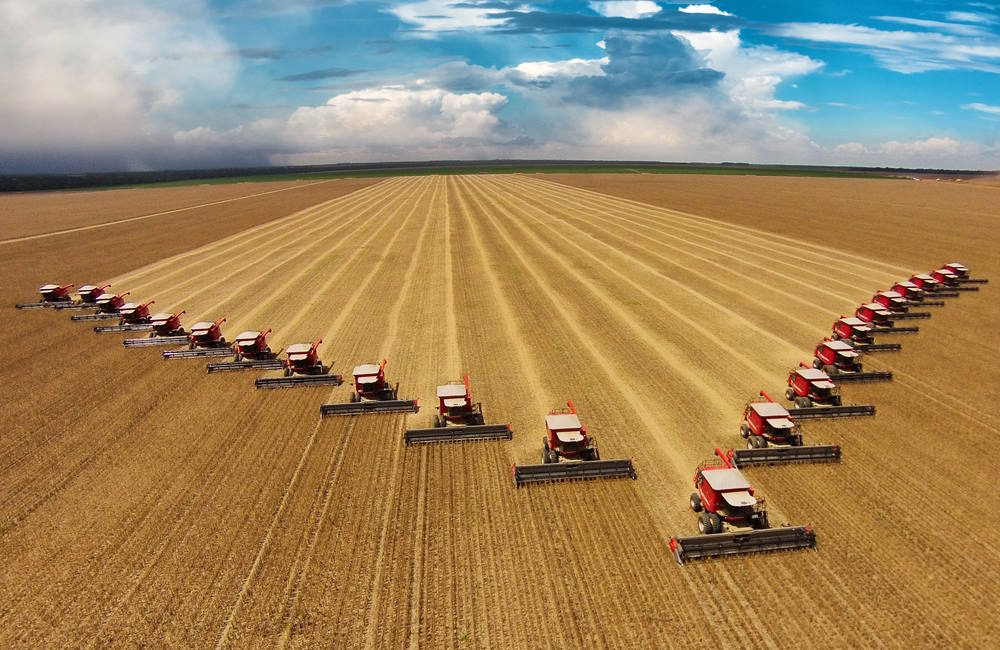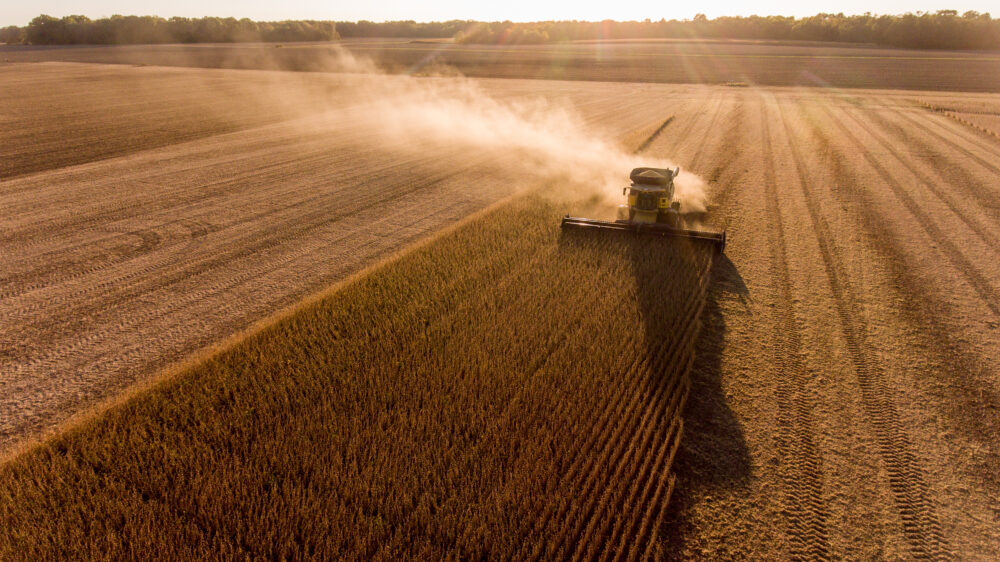Ag Market Investing Offers Diversification, Hedge Against Other Holdings
Share This Story, Choose Your Platform!
As investors sweat out the latest stock market swing, interest rate decision or inflation data, many wrestle with the question of what to do with their portfolio if the economy really starts to go south. Some will ride it out with their current slate of stock market and real estate investments, noting the track record of that approach over the long run. Others will actively seek out alternative asset classes to diversify their portfolios.
Those who opt for the latter will find the agricultural sector worth consideration. Population growth in developing nations, as well as limited farmland and resources, ensure that agriculture market investing will remain ripe for speculation. Agricultural products have a relatively low correlation with the U.S. stock market, making them a useful tool for portfolio managers looking to hedge other holdings.
The core Ag markets are staple crops such as corn, wheat, soybeans, and cotton. Grain and oilseed prices will correlate with each other, and they are a significant determinant of livestock prices, but they are not correlated to the value of your Tesla stock.
What Are the Best Choices in Agriculture Market Investing?
Investing in agriculture can seem daunting to the uninitiated. Assuming your clients are not interested in owning an actual farm or grain elevator, there are a few avenues for passive investment. One can purchase shares of stock in agribusiness corporations, ETF’s, Farmland REITs or derivatives contracts.
Agribusiness Company Stock
Agribusiness may do well if the economy as a whole is doing well, but they will have a high correlation to the overall stock market – exactly what you are trying to avoid. The multinational conglomerates have many revenue streams and do an excellent job of hedging their price risk, which means they are not great proxies for commodity prices. Smaller, more specialized companies may track closely with the commodity they supply, but such companies often have unknown risk vectors.
Exchange Traded Fund (ETF) or Exchange Traded Note (ETN)
This is the simplest way for smaller net-worth investors to speculate on the price of agricultural commodities. Agriculture ETFs and ETNs typically manage a basket of futures in order to approximate the value of the underlying commodity they represent. It is essentially a means of turning futures contracts into equities, making them easily accessible. Many have relatively low expense ratios, but the pricing mechanics can be complicated. Read the description carefully, as some ETFs labeled as “Ag” are baskets of agribusiness company stock, which obviously possess the same as the previous example.
Real Estate Investment Trust (REIT)
Owning a small percentage of multiple farms is an attractive option for many big city investors. With billionaires around the globe aggressively buying up America’s farmland, this appears to be a hot growth sector. You’ll be bidding against the likes of Blackrock and Bill Gates. REITs vary so much in scope and nature that it’s difficult to evaluate them as group. There are broad-based or focused strategies, as well as high-risk or conservative, and many gradations in between. The structure of these contracts may be convoluted, so be certain that you fully understand the prospectus.
Futures and Options
In our opinion, this is one of the the best ways to invest in agriculture. Standardized exchange-listed commodity futures have been around for more than 100 years, and the markets for them are incredibly active and liquid (some more than others, of course). The vast array of contract specifications allows for highly customizable portfolio strategies.
The values reflected in these markets are the result of competitive price discovery on a global scale. The technical relationship of a futures contract with its underlying commodity is simple and straightforward. Options are one degree more complex, but still very well defined and easy to understand, at least conceptually.
For many investors, the most alluring attribute of commodity futures and options would be their tax advantage over traditional equities (talk to your accountant). The downside for Series 7 investment managers is that you may need to obtain a Series 3 license before partaking in commodity futures markets on behalf of your clients.
What and When to Trade in Ag Market Investing?
Whichever vehicle you choose, look for an investment with sound fundamentals that will be robust in various economic situations. The stock market doesn’t need to crumble in order for Ag investing to be a good idea. The point of diversification is that we don’t know exactly how the stock market will behave. If we did, we wouldn’t need to diversify in the first place.
It’s imperative to learn the fundamentals and how to interpret them, even if you are a technical trader. Some products lend themselves to fundamental analysis better than others. For example, grains such as corn and wheat, oilseeds such as soybeans and soybean oil, and fibers such as cotton lend themselves very well to fundamental analysis.
Supply demand data is readily available, updated monthly and can give informed investors a clear picture of where futures might be headed. Crop prices are highly dependent on the planting/harvest cycle, which Ag investors should be familiar with for each product that they trade.
For those interested in something more exotic – coffee, cocoa and orange juice futures can provide a good deal of diversification and profit potential. To gain an edge in these markets, one can study weather patterns, global trade, technological developments and cultural trends.
Commodities Trading Provides Fascinating Insights Into Economy
In addition to the potential financial rewards, commodity trading is infinitely fascinating. There is an extraordinarily complex framework in which the prices of commodities influence each other, and the greater economy.
Some of these relationships are obvious, but others appear strange or counterintuitive. Corn is used to feed cattle. Natural gas is used to make fertilizer, a key production cost for most crops. The right amount of rainfall in India will cause a bumper harvest resulting in wealthier farmers which leads to greater consumer demand for gold. Every commodity is impacted by the price of oil in its own particular way. A dedicated commodity trader will spend a lifetime trying to understand all of the nuances.
For beginners just learning to trade these markets, it’s best to focus on the broad fundamentals. Don’t try to reinvent the wheel or outsmart everyone else in the market. If you’re new at this, the trend is your friend.
Springtime is the right time for trading agricultural commodities. Planting is in full swing in the U.S., which often leads to historically repeated price patterns – seasonality – which is discussed in more detail here.
Share This Story, Choose Your Platform!
Ag Market Investing Offers Diversification, Hedge Against Other Holdings
Share This Story, Choose Your Platform
As investors sweat out the latest stock market swing, interest rate decision or inflation data, many wrestle with the question of what to do with their portfolio if the economy really starts to go south. Some will ride it out with their current slate of stock market and real estate investments, noting the track record of that approach over the long run. Others will actively seek out alternative asset classes to diversify their portfolios.
Those who opt for the latter will find the agricultural sector worth consideration. Population growth in developing nations, as well as limited farmland and resources, ensure that agriculture market investing will remain ripe for speculation. Agricultural products have a relatively low correlation with the U.S. stock market, making them a useful tool for portfolio managers looking to hedge other holdings.
The core Ag markets are staple crops such as corn, wheat, soybeans, and cotton. Grain and oilseed prices will correlate with each other, and they are a significant determinant of livestock prices, but they are not correlated to the value of your Tesla stock.
What Are the Best Choices in Agriculture Market Investing?
Investing in agriculture can seem daunting to the uninitiated. Assuming your clients are not interested in owning an actual farm or grain elevator, there are a few avenues for passive investment. One can purchase shares of stock in agribusiness corporations, ETF’s, Farmland REITs or derivatives contracts.
Agribusiness Company Stock
Agribusiness may do well if the economy as a whole is doing well, but they will have a high correlation to the overall stock market – exactly what you are trying to avoid. The multinational conglomerates have many revenue streams and do an excellent job of hedging their price risk, which means they are not great proxies for commodity prices. Smaller, more specialized companies may track closely with the commodity they supply, but such companies often have unknown risk vectors.
Exchange Traded Fund (ETF) or Exchange Traded Note (ETN)
This is the simplest way for smaller net-worth investors to speculate on the price of agricultural commodities. Agriculture ETFs and ETNs typically manage a basket of futures in order to approximate the value of the underlying commodity they represent. It is essentially a means of turning futures contracts into equities, making them easily accessible. Many have relatively low expense ratios, but the pricing mechanics can be complicated. Read the description carefully, as some ETFs labeled as “Ag” are baskets of agribusiness company stock, which obviously possess the same as the previous example.
Real Estate Investment Trust (REIT)
Owning a small percentage of multiple farms is an attractive option for many big city investors. With billionaires around the globe aggressively buying up America’s farmland, this appears to be a hot growth sector. You’ll be bidding against the likes of Blackrock and Bill Gates. REITs vary so much in scope and nature that it’s difficult to evaluate them as group. There are broad-based or focused strategies, as well as high-risk or conservative, and many gradations in between. The structure of these contracts may be convoluted, so be certain that you fully understand the prospectus.
Futures and Options
In our opinion, this is one of the the best ways to invest in agriculture. Standardized exchange-listed commodity futures have been around for more than 100 years, and the markets for them are incredibly active and liquid (some more than others, of course). The vast array of contract specifications allows for highly customizable portfolio strategies.
The values reflected in these markets are the result of competitive price discovery on a global scale. The technical relationship of a futures contract with its underlying commodity is simple and straightforward. Options are one degree more complex, but still very well defined and easy to understand, at least conceptually.
For many investors, the most alluring attribute of commodity futures and options would be their tax advantage over traditional equities (talk to your accountant). The downside for Series 7 investment managers is that you may need to obtain a Series 3 license before partaking in commodity futures markets on behalf of your clients.
What and When to Trade in Ag Market Investing?
Whichever vehicle you choose, look for an investment with sound fundamentals that will be robust in various economic situations. The stock market doesn’t need to crumble in order for Ag investing to be a good idea. The point of diversification is that we don’t know exactly how the stock market will behave. If we did, we wouldn’t need to diversify in the first place.
It’s imperative to learn the fundamentals and how to interpret them, even if you are a technical trader. Some products lend themselves to fundamental analysis better than others. For example, grains such as corn and wheat, oilseeds such as soybeans and soybean oil, and fibers such as cotton lend themselves very well to fundamental analysis.
Supply demand data is readily available, updated monthly and can give informed investors a clear picture of where futures might be headed. Crop prices are highly dependent on the planting/harvest cycle, which Ag investors should be familiar with for each product that they trade.
For those interested in something more exotic – coffee, cocoa and orange juice futures can provide a good deal of diversification and profit potential. To gain an edge in these markets, one can study weather patterns, global trade, technological developments and cultural trends.
Commodities Trading Provides Fascinating Insights Into Economy
In addition to the potential financial rewards, commodity trading is infinitely fascinating. There is an extraordinarily complex framework in which the prices of commodities influence each other, and the greater economy.
Some of these relationships are obvious, but others appear strange or counterintuitive. Corn is used to feed cattle. Natural gas is used to make fertilizer, a key production cost for most crops. The right amount of rainfall in India will cause a bumper harvest resulting in wealthier farmers which leads to greater consumer demand for gold. Every commodity is impacted by the price of oil in its own particular way. A dedicated commodity trader will spend a lifetime trying to understand all of the nuances.
For beginners just learning to trade these markets, it’s best to focus on the broad fundamentals. Don’t try to reinvent the wheel or outsmart everyone else in the market. If you’re new at this, the trend is your friend.
Springtime is the right time for trading agricultural commodities. Planting is in full swing in the U.S., which often leads to historically repeated price patterns – seasonality – which is discussed in more detail here.






